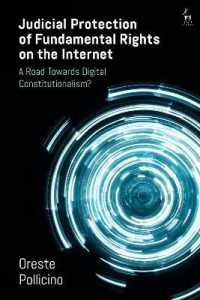- ホーム
- > 洋書
- > 英文書
- > Business / Economics
Full Description
Who were key figures in the making of European monetary union? Which ideas did they contribute to ensuring that monetary union would be sustainable? How prescient were they in identifying the necessary and sufficient foundations of a sustainable monetary union?
This book provides the first systematic historical examination of key architects of European monetary union in the period before its launch in 1999. Using original archival and interview research, it investigates the intellectual and career backgrounds of these architects, their networking skills, and their own doubts and reservations about the way in which monetary union was being constructed. In the light of the later Euro Area, Architects of the Euro deals critically with not just their contribution to the making of European monetary union but also their legacy. The book brings together a distinguished group of scholars working on the history of Economic and Monetary Union.
Contents
Jan Smets: Foreword
1: Kenneth Dyson and Ivo Maes: Intellectuals as Policy Makers: Biography and the History of European Monetary Union
2: Ivo Maes and Eric Bussière: Robert Triffin: The Arch Monetarist in the Process of European Monetary Integration?
3: Katja Seidel: Robert Marjolin: Securing the Common Market through Economic and Monetary Union
4: David Howarth: Raymond Barre: Modernizing France through European Monetary Cooperation
5: Elena Danescu: Pierre Werner: A Visionary European and Consensus Builder
6: Piers Ludlow: Roy Jenkins and the Importance of Top-Level Politics
7: Kenneth Dyson: Hans Tietmeyer, Ethical Ordo-liberalism, and the Architecture of EMU: Getting the Fundamentals Right
8: Harold James: Karl-Otto Pöhl: The Pole Position
9: Fabio Masini: Tommaso Padoa-Schioppa: EMU as the Anchor Stone for Building a Federal Europe
10: Dermot Hodson: Jacques Delors: Vision, Revisionism, and the Design of EMU
11: Ivo Maes: Alexandre Lamfalussy: A Cassandra about Financial Stability
12: Kenneth Dyson and Ivo Maes: Contributions, Legacies, and Lessons








